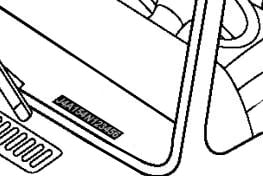VIN History
In the mid 1950's American automobile manufacturers began stamping and casting identifying numbers on cars and their parts. The vehicle identification number has become referred to as the "VIN". The obvious purpose was to give an accurate description of the vehicle when mass production numbers were starting to climb in very significant numbers. Research has shown that early Vin's came in all sorts of variations which depended on the individual manufacturer at that time.
In the early 1980's the National highway Traffic Safety Administration (U.S. Dept. of Transport) required that all road vehicles must contain a 17 character VIN. This established the fixed VIN system for major vehicle manufacturers as it is known today. Thus, establishing a unique "DNA" style number for each unique vehicle which rolled off the assembly line.
The VIN has 17 characters to provide details about your Jeep. Each character represents something about your Jeep except the check digit character. This character is called a "check digit" because it is designed to protect the consumer from theft and possible fraud. The manufacturer is required to include a check digit in the ninth position by U.S. federal law. The check digit is used by the manufacturer and government agencies to verify authenticity of the vehicle and official documentation. The algorithm used to determine a check digit is not released to the public for obvious reasons, however the secret has been leaked and the check digit can be calculated.
Location of the VIN
The most common place to find your VIN (Vehicle Identification Number) is on a small metal plate attached to the driver side top of the dashboard. The tag is designed to be visible through the windshield for easy access. Every car is required to have one of these and all of them are located in this one place. It is illegal to remove or change this plate. If the tag is missing, chances are the vehicle has been repaired, or was most likely, stolen.
Other places where you might find your vehicles' VIN number:
- Vehicle Identification Label in your Owner's Manual
- Stamped on the frame under the front hood
- On a sticker on the driver's side door pillar
- On state vehicle registration certificate
- On the vehicle title of ownership
- New cars have the VIN on the price sticker
- A label in the luggage/spare tire area
Parts of the VIN
There are two different standards for the Vehicle Identification Number. The ISO standard, 3779, is copied by the European Union. In North America, a more stringent (but compatible) system is used.
The VIN is composed of the following sections:
| Standard | 1 | 2 | 3 | 4 | 5 | 6 | 7 | 8 | 9 | 10 | 11 | 12 | 13 | 14 | 15 | 16 | 17 |
| ISO 3779 | WMI | VDS | VIS | ||||||||||||||
| ISO 3779 | Manufacturer Identifier | Vehicle Attributes | Check Digit | Model Year | Plant Code | Sequential Number | |||||||||||
ISO 3779: WMI
ISO 3779: Manufacturer Identifier
Standard: 2
ISO 3779: WMI
ISO 3779: Manufacturer Identifier
Standard: 3
ISO 3779: WMI
ISO 3779: Manufacturer Identifier
Standard: 4
ISO 3779: VDS
ISO 3779: Vehicle Attributes
Standard: 5
ISO 3779: VDS
ISO 3779: Vehicle Attributes
Standard: 6
ISO 3779: VDS
ISO 3779: Vehicle Attributes
Standard: 7
ISO 3779: VDS
ISO 3779: Vehicle Attributes
Standard: 8
ISO 3779: VDS
ISO 3779: Vehicle Attributes
Standard: 9
ISO 3779: VDS
ISO 3779: Check Digit
Standard: 10
ISO 3779: VIS
ISO 3779: Model Year
Standard: 11
ISO 3779: VIS
ISO 3779: Plant Code
Standard: 12
ISO 3779: VIS
ISO 3779: Sequential Number
Standard: 13
ISO 3779: VIS
ISO 3779: Sequential Number
Standard: 14
ISO 3779: VIS
ISO 3779: Sequential Number
Standard: 15
ISO 3779: VIS
ISO 3779: Sequential Number
Standard: 16
ISO 3779: VIS
ISO 3779: Sequential Number
Standard: 17
ISO 3779: VIS
ISO 3779: Sequential Number
Courtesy of Jeepfan.com





